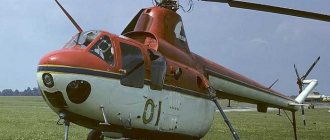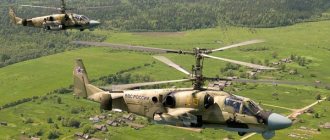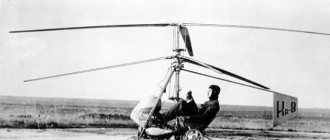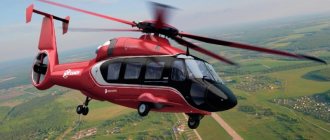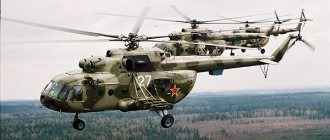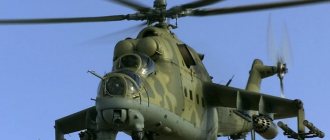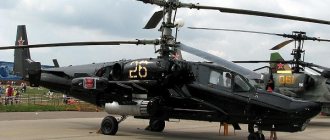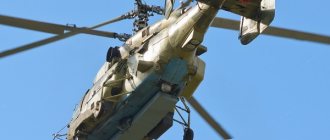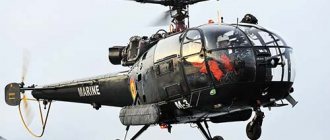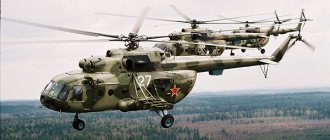In the 80s, the US Air Force added a new helicopter, the AH-64, better known as the “Apache,” designed for offensive operations. It became the first army combat helicopter designed to carry out joint combat operations with ground forces and conduct anti-tank operations.
The AH-64 played an important role in the formation of the American Air Force, becoming an iconic model. The helicopter took part in several armed conflicts and was also used in the filming of films. Today it is the second most common in the world (the primacy remains with the Soviet Mi-24).
Story
The idea of using combat helicopters was confirmed by the results of the use of AH-1 Cobra machines in the Vietnam War. It was unclear which model would become the basis for combat units.
The main contender for this position, the AH-56 Cheyenne helicopter program, was canceled in 1972 due to high costs. Attempts to replace the AH-1 with the S-67 and an upgraded version of the S-61 were unsuccessful.
By 1972, the US Air Force announced a program to develop an updated combat helicopter, codenamed AAH (Advanced Attack Helicopter). The AN-64 “Apache” (or model 77) was created and positioned as a helicopter for destroying enemy armored vehicles in any conditions and at any time of the day.
It received its name in honor of the Indian tribe of the same name, which previously lived in the United States.
The finished sample was tested in September 1975. Six years later it received the official name - “Apache”. The first production helicopter took off only in 1984, and deliveries of this model began a year later. By that time, the development company became part of the Mc Donnell Douglas corporation.
Production of this model continues to this day, with parallel production being carried out by Boeing Integrated Defense Systems.
History[edit]
The successful use of the AH-1 Cobra in Vietnam confirmed the viability of the idea of a combat helicopter. At the same time, the situation with the supposed “heir” of Cobra remained unclear. The ambitious and expensive AH-56 Cheyenne program lasted about a decade and was finally canceled in 1972. Attempts to find a temporary replacement in the form of the Sikorsky S-67 model, modifications of the S-61 and other helicopters were also unsuccessful. Finally, in 1972, the US Army began the Advanced Attack Helicopter (AAH) program, designed primarily to combat enemy tanks at any time of day and in bad weather conditions.
The main requirements put forward for the AAH helicopter:
- Armament - 30-mm M230 Chain Gun, 16 AGM-114 anti-tank missiles or 4 installations with 19 units of 70-mm Hydra 70 NAR
- Crew - 2 people
- Characteristics: estimated take-off weight - 7260 kg, rate of climb - 12.7 m/s, ferry range with PTB - 1850 km
- Navigation equipment for flights at night and in bad weather conditions at an altitude of less than 30 m
- The engine is a gas turbine XT-700, which ensured unification with the UH-60 military transport helicopter being developed
- IR Reduction System
- Ensuring helicopter combat survivability. In particular, the helicopter’s zero vulnerability when hit by a single 12.7 mm bullet at a speed of 490 m/s and minimization of vulnerability when hit by a 23 mm OFZ projectile. The ability to continue flight for at least 30 minutes after the specified impact on any part of the machine structure
- Estimated service life - 15 years
- The estimated cost of the serial machine is 14 million dollars, the cost of production is 11 - 12 million dollars.
Five aircraft manufacturing companies took part in the competition: Boeing-Vertol, Bell, Hughes, Lockheed, Sikorsky. In June 1973, two of these firms (Bell and Hughes) were awarded contracts to develop and produce prototypes. Bell offered the YAH-63 (Model 409), which was a development of the AH-1; The prototype made its first flight on November 22, 1975. A little earlier, on September 30, the Hughes YAH-64 took off for the first time, piloted by test pilots Robert Ferry and Raleigh Fletcher. During comparative tests conducted by the army, the Hughes model showed its significant superiority over its competitor in climb rate and maneuverability, and in general its characteristics exceeded army requirements. The accident of the YAH-63 in one of the test flights also played a role. In December 1976, it was announced that the Hughes company had won the competition with the YAH-64 helicopter.
After winning the competition, the company continued extensive testing of the helicopter, making a number of changes to its design and on-board equipment. In total, the volume of flight tests amounted to 2400 hours. Due to a number of difficulties, the decision on mass production was postponed for two years. Only in the summer of 1981 did military testing of the helicopter begin. The combat crews were satisfied with the new machine, and on December 19 of the same year, a decision was made to mass produce the helicopter under the designation AH-64A and the name “Apache.”
To produce Apaches, a plant was built in Mesa (Arizona). The rollout of the first production vehicle took place on September 30, 1983, exactly eight years after the first flight of the AH-64. The following year, the Hughes company was purchased by the McDonnell-Douglas Corporation, which also took over the production of the helicopter. “Apaches” began to enter the troops and were distributed in 18 helicopters per squadron. The first squadron reached combat readiness in July 1986. Since 1989, Apaches began to enter the US National Guard. Serial production for the needs of the American armed forces was completed in December 1994 after the construction of 827 vehicles. The average cost of one early modification AH-64A helicopter is estimated at approximately $14.5 million.
Modifications
The US Armed Forces praised the vehicle. Over time, new versions of the Apache appeared, and the designers modified the helicopter to perform various combat missions.
ModelAN-64A, designed specifically to protect the fleet and marines from enemy naval forces, as well as for conducting reconnaissance in particularly remote areas.
The Apache helicopter is capable of operating at a distance of up to 240 km from its home point.
AN-64B version, updated based on the experience gained in the conflicts in the Persian Gulf. The main differences were:
- increased wing span compared to the original version;
- modified cockpit layout;
- boosted power plant;
- Fuel tanks with an increased volume were used, ensuring an expansion of the range by 200 km.
The third modification of the Apache was the AN-64S, distinguished by the removed Longbow radar and upgraded engines. The car was launched into the air in 1992. The first results encouraged the customer, and it was decided to bring a batch of 308 helicopters of the AH-64A modification to the 64C standard. But by 1993, the program was considered ineffective and then closed.
The AH-64D "Longbow" series represents another attempt to improve the helicopter's performance. The antenna on the vehicles was raised above the propeller planes and an improved version of the Dash 701C and T700-GE-701C engines was installed. The list of weapons was supplemented with AGM-114 Hellfire anti-tank missiles. 227 Apache helicopters were modernized. The updated models were put into operation in 1996.
The AH-64E "Guardian" is a further development of the AH-64D. Compared to its predecessor, it has significant changes:
- Apache propeller blades are made of composite materials;
- an improved version of the engine with a power of 2000 hp each was used;
- new electronics and control system installed;
- an updated weapons control radar, target detection and data transmission system were used.
See also[edit]
Comparative performance characteristics of modern attack helicopters
| Mi-28N | Ka-52 | AH-64D Apache Longbow (Block III) | Bell AH-1Z Viper | AugustaWestland T129 | Eurocopter Tiger |
| Appearance | ||||||
| Year of adoption | 2009 | 2011 | 2011 | 2011 | 2012 | 2003 |
| Empty weight, kg | 8095 | 7800 | 5165 | 5580 | 2530 | 3060 |
| Fuel weight, kg | 1500 | 1500 | 1100 | n/a | n/a | 1100 |
| Weight of combat load, kg | 2300 | 2800 | n/a | n/a | 1200 | n/a |
| Built-in cannon | 1 × 30 mm 2A42 | 1 × 30 mm 2A42 | 1 × 30mm M230 | 3 × 20 mm M197 | 3 × 20 mm M197B | 1 × 30 mm GIAT 30 |
| Suspension points | 4 | 6 | 4 | 6 | 4 | 4 |
| Maximum take-off weight, kg | 12 000 | 10 800 | 10 400 | 8390 | 5000 | 6600 |
| Power point | 2 × VK-2500-02 | 2 × VK-2500 | 2 × General Electric T700-GE-701D | 2 × General Electric T700-GE-401C | 2 × LHTEC CTS800-4A | 2 × Rolls-Royce MTR390-E |
| Engine power, l. With. | 2 × 2200 | 2 × 2400 | 2 × 2000 | 2 × 1800 | 2 × 1360 | 2 × 1464 |
| Maximum speed, km/h | 300 | 310 | 265 | 300 | 280 | 290 |
| Practical range (without PTB), km | 450 | 520 | 480 | 680 | 550 | 740 |
| Practical ceiling, m | 5000 | 5500 | 5900 | 6100 | 6000 | 4000 |
| Rate of climb, m/s | 13,6 | 16,0 | 12,3 | 14,2 | 11,3 | 14,0 |
| Cost, million USD | ~27,0 | 52,0-61,0 | 27,0-31,0 | 43,0-53,0 | 39,0 |
| Denel AH-2 Rooivalk | Kawasaki OH-1 Ninja | Harbin Z-19 | CAIC WZ-10 | HAL LCH | HESA Shahed 285 |
| Year of adoption | 1999 | 2000 | — | 2011 | 2013 (plan) | n/a |
| Empty weight, kg | 5730 | 2450 | 2350 | 5400 | 3000 | 820 |
| Fuel weight, kg | 1470 | n/a | n/a | n/a | n/a | n/a |
| Weight of combat load, kg | 1560 | n/a | n/a | 1500 | n/a | n/a |
| Built-in cannon | 1 × 20 mm F2 | — | 1 × 23 mm | 1 × 23 mm | 1 × 20 mm | 1 × 7.62 mm |
| Suspension points | 6 | 4 | 4 | 4 | 4 | 2 |
| Maximum take-off weight, kg | 8750 | 4000 | 4500 | 7500 | 5500 | 1450 |
| Power point | 2 × Turbomeca Makila 1K2 | 2 × Mitsubishi TS1-10QT | 2 × WZ-8A | 2 × Pratt & Whitney Canada PT6C-67C | 2 × HAL/Turbomeca Shakti | 1 × Allison 250-C20J |
| Engine power, l. With. | 2 × 1500 | 2 × 890 | 2 × 850 | 2 × 1530 | 2 × 1200 | 1 × 420 |
| Maximum speed, km/h | 280 | 280 | 245 | n/a | 275 | 225 |
| Practical range (without PTB), km | 700 | 550 | 700 | n/a | 700 | 800 |
| Practical ceiling, m | 6100 | n/a | 4900 | n/a | 6000 | 4150 |
| Rate of climb, m/s | 13,3 | n/a | 9,0 | n/a | 12,0 | 7,0 |
| Cost, million USD | ~40,0 | n/a | n/a | n/a | ~22,0 | n/a |
The Boeing/Sikorsky RAH-66 Comanche is another helicopter named after a Native American tribe.
Design
The Apache fuselage has a standard shape (semi-monocoque), made of aluminum alloys and high-strength and tough materials. The machine is built according to a single-rotor design with 4-bladed main and tail rotors. The X-shaped tail rotor is less noisy, and the angled blades suppress some of the main rotor noise.
There is a removable low aspect ratio wing.
A 3-post, awkward landing gear with one tail wheel and enhanced shock absorption is responsible for landing the Apache. It can withstand normal landing (at speeds up to 3.05 m/s) and emergency landings (up to 12.8 m/s). It is allowed to take off and land a helicopter from surfaces with a small angle of inclination (up to 12° in the longitudinal direction and up to 15° in the transverse direction).
The Apache helicopter used advanced equipment at the time of its creation. All guidance, target tracking and battlefield assessment systems were located in the bow.
The equipment of the AH-64 helicopter included:
- TADS target detection and indication system.
- The PNVS system, which is an improved version of the FLIP complex, is responsible for providing pilots with night vision. The equipment includes an on-board IR viewing system for the front hemisphere with 30x magnification.
- The Apache pilots' helmets were equipped with the IHADSS integrated targeting system. It makes it possible to fully control existing weapons by moving your head.
The TADS (Target Acquisition and Designation Sights, night vision system) electro-optical system includes:
- laser pointer equipped with a tracking system (LRF/D);
- IR viewing system of the front hemisphere;
- daytime (DT) television display system.
The PNVS system provided the Apache pilot with all the relevant information necessary to perform combat missions. All helicopter equipment gave the pilots the following viewing angles:
- ± 120° in azimuth.
- +30°/-60° in elevation angle.
The flight of the Apache helicopter is powered by two turboshaft engines, each with a take-off power of 1695 hp. The AH-64 engines are installed in nacelles on the sides of the fuselage. Fuel was supplied from two protected tanks, the total capacity of which is 1157 liters. One tank is installed behind the pilot’s seat, and the second is installed behind the main gearbox. Additionally, 4 outboard fuel tanks of 870 liters each can be attached to the wing weapon suspension units.
The cockpit is protected from below and on the sides by armor. A transparent protective partition made of Kevlar and polyacrylate is installed between the seats. The AH-64's armor provided partial protection against armor-piercing bullets up to 12.7 mm in caliber and small-caliber anti-aircraft gun shells. Additional protection is provided by fuel tanks, and duplication of hydraulic systems is also used.
The crew of the Apache vehicle consists of 2 people located in tandem in the cockpit. The seat of the second pilot-on-board weapons operator is installed in front. Behind it is the main pilot’s workplace, raised by 483 mm.
The AH-64 Apache's armament is located on 4 mounts under the short wings.
Armament was combined in various proportions, based on the goals and objectives of the operation. Posted here:
- up to 16 Hellfire anti-tank missiles (hitting point targets and equipped with an autonomous guidance system);
- 76 pieces of 70-mm rockets with folding fins “Hydra”;
- At the ends of both wings it was possible to place the Stinger missile launcher.
In addition, a single-barrel M230E1 “Chain Gun” automatic cannon with a maximum ammunition load of 1,200 rounds was installed under the Apache fuselage.
About the cabin design
The Apache attack helicopter is equipped with a two-seater cabin, which is characterized by a tandem seat arrangement. The front one is intended for the second pilot-gunner, and the rear one, raised by 480 mm, is for the pilot. The lower part and sides of the cabin are covered with armor. The space between the seats became a place for a transparent partition. Kevlar and polyacrylate are used in its manufacture. This partition is capable of withstanding a direct hit from a bullet and projectile, the calibers of which vary from 12.7 to 23 mm. Thanks to this cabin design, the flight crew is provided with maximum protection.
In an effort to increase the combat survivability of the Apache helicopter, American designers in the helicopter use two independent hydraulic systems, protected fuel tanks and armored most important systems and areas.
The design of the Russian Ka-52 helicopter (according to NATO classification it is listed as “Alligator”) is characterized by a coaxial design. The cabin in this “turntable” is double. However, the seats are located side by side to each other. There are no restrictions for piloting in the Alligator. Thus, both pilots can fire and control the helicopter. The helicopter cabin is equipped with a special armored capsule. The crew can eject at an altitude of at least 4,100 m. The armored coating protects pilots from bullets of caliber no higher than 23 mm.
Combat use
Various modifications of the Apache were used in well-known military conflicts, for example, during the 1989 fighting in Panama or during Operation Desert Storm in 1991 (then more than 200 AH-64 helicopters were involved).
The AH-64 Apache was first tested in combat during the American invasion of Panama in December 1989. The experience of use was small: only 11 helicopters of this model were used, and AGM-114 missiles were launched (successfully) several times.
They played a more significant role during Operation Desert Storm. Then the Apaches fired the first shots of this war, hitting Iranian radar stations in Baghdad and destroying both radars. In military operations with Iranian troops, the AN-64 proved to be an effective anti-tank weapon (from 200 to 500 tanks and other armored vehicles were destroyed).
Helicopters have proven themselves to be suitable equipment for supporting ground forces. During the entire period of the operation, only 3 Apache helicopters were lost.
The combat equipment allowed the Apache to successfully destroy tanks by striking from long distances.
This not only made the helicopter inaccessible to ground vehicles, but also allowed the AH-64 to destroy targets far from the nearest enemy air defense zone (up to 8 km), making the Apache a more difficult target. As a result, MANPADS of that time (Igla, Stinger and Verba) also could not hit a helicopter and cover their tanks from their fire.
Further, “Apaches” were used in 1999 in Yugoslavia. Apaches were used in NATO operations in Albania and supported the planned ground offensive in Kosovo. The helicopters never took part in real combat operations; they were only involved in training flights a few times and participated in the defense of air bases.
The peak use of the AH-64 occurred in 2003. Then the invasion of Iraq took place, where they were actively used in battle. Several modifications of the Apache helicopter were tested here, for example, the AH-64D.
Video
The second half of the 20th century became the “finest hour” for the development of helicopters. Such machines were almost never used during the Second World War, but already in the Korean War, helicopters were used in the most active way. The Americans became pioneers in the use of helicopters on the battlefield. The development of helicopter manufacturing in the USA is associated with the name of Igor Sikorsky, a talented engineer, a native of Kyiv, who left for the USA after the October Revolution.
Although, it should be noted that at first these machines had a large number of opponents. The US Air Force did not want to purchase helicopters at all, citing poor performance, difficulty in maintenance and possible vulnerability to air defense systems. Alas, the military very often suffer from inertia of thinking. But this attitude very quickly changed to the opposite. Helicopters performed well in the Korean War.
They were used for fire adjustment, reconnaissance, evacuation of the wounded, landing troops and other purposes. After several months of fighting, American generals demanded that they be given “more turntables.”
Before the advent of helicopters, soldiers who received moderate or severe wounds were practically doomed (90% died). After the start of the “helicopter” era, mortality dropped to 10%. Towards the end of the Korean conflict, small light machine guns began to be installed on helicopters. The US Army already had several types of helicopters in service. The Korean War showed that the helicopter is an excellent tool for solving tactical problems, primarily related to the transfer of troops and their supply. In the second half of the 20th century, many local conflicts and colonial wars occurred, in which one of the parties was forced to wage an anti-partisan struggle. And it turned out that a helicopter is an ideal means for this kind of combat operations.
The helicopter is increasingly becoming not just a vehicle, but also an attack vehicle, an ideal attack aircraft and a means of supporting ground forces. Unguided missiles and machine guns began to be installed on helicopters, and with the advent of anti-tank guided missiles, the helicopter became a powerful weapon in the fight against armored vehicles.
An important milestone in the development of combat helicopters was the Vietnam War. The real symbol of this war was the American Bell UH-1 helicopter, better known as the Huey.
This wonderful, reliable and unpretentious car is still in production. Another helicopter that was actively used in the Vietnamese jungle was the attack helicopter. Its main task was to support troops and strike the enemy.
By the end of hostilities, special divisions were formed in the US Army, armed only with helicopters. The Vietnam War gave a sharp impetus to the development of helicopter manufacturing in the United States.
At the end of the 70s of the last century, the United States began to think about creating a new attack helicopter; it was supposed to incorporate all the experience gained in Vietnam and replace the Bell AH-1 Cobra. Several of the largest American aircraft manufacturing companies took part in the competition to develop a new helicopter. In 1976, the victory went to the Hughes company, and in 1981 the AN 64 Apache helicopter appeared, which is still in service with the US Army and is considered one of the best combat helicopters in the world. Since 1984, AN 64 has been mass-produced.
Is it currently in service?
The US Armed Forces still use the AH-64 Apache, with six hundred helicopters. This model was purchased by the armed forces of America's allies:
- Israel.
- Saudi Arabia.
- Egypt.UAE.
- Greece.
- England.
- China.
- Netherlands.
- India.
- South Korea.
- Japan and several other small states.
In total, more than 2,000 Apache helicopters were produced. The design features of the AH-64 allow it to be upgraded with new, more modern combat systems.
Notes[edit]
- ↑ Jane's All The World's Aircraft 2004-2005 / Paul Jackson. - Jane's Information Group, 2004. - P. 594-597. — 860 p. — ISBN 0-7106-2614-2.
- World Air Forces 2015, p.8
- World Aviation Magazine Issue No. 20
- ↑
- “Apache Helicopter Was Considered Effective in Combat, but Reliability Problems Persist” General Accounting Office, April 1992
- Battle Became Route. Ellensburg Daily Record, February 28, 1991, p. 9.
- Apache Operation a lesson in defeat The Washington Times, April 22, 2003. Rowan Scarborough
- In the Company of Soldiers. Paw Prints. Rick Atkinson. 2008. pp.147-153
- AH-64 Apache Units of Operations Enduring Freedom and Iraqi Freedom. Osprey Publishing. Jonathan Burstein. 2005. p.51
- Ponomarev A. N. et al.
Combat helicopter for fire support of ground troops AH-64A “Apache” (USA). - M.: Military Publishing House, 1986. - 39 p. - The Military Balance 2010. p.-169
- The Military Balance 2010. p.-137
- The Military Balance 2010. p.-250
- The Military Balance 2010. p.-256
- The Military Balance 2010. p.-260
- The Military Balance 2010. p.-150
- The Military Balance 2010. p.-276
- The Military Balance 2010. p.-270
- The Military Balance 2010. p.-426
- The International Institute for Strategic Studies IISS.
The Military Balance 2010. - Nuffield Press, 2010. - P. 33. - 492 p. — ISBN 9781857435573. - The Military Balance 2010. p.-408
Performance characteristics
The cost of one “turntable” was about $50,000,000. Below is a comparison of the AH-64 Apache with two other helicopters produced at approximately the same time - MI 24 and MI 28.
| Characteristics | AN-64 | MI-24 | MI-28 |
| Fuselage length, m | 10,59 | 17,51 | 16,85 |
| Fuselage width, m | 2,03 | 1,7 | 2.27 |
| Helicopter height, mHelicopter height, m | 4,66 | 3,9 | 3, 82 |
| Main rotor diameter, m | 14,63 | 17,3 | 17,2 |
| Tail rotor diameter, m | 2,79 | 3,908 | 3,82 |
| Crew, people | 2 | 2 (up to 8 paratroopers) | 2 |
| Maximum take-off weight, kg | 9525 | 11500 | 11700 |
| Engines, number and power, hp | 2*1 890 | 2*2500 | 2*1950 |
| Maximum speed, km/h | 293 | 335 | 300 |
| Ceiling, m | 4570 | 4950 | 5700 |
| Flight range, km | 482 | 450 | 435 |
The MI-24 was one of the first attack helicopter models produced in the USSR. It was originally intended to transport troops behind enemy lines and support friendly forces from the air. But later it became clear that it was less suitable for transporting soldiers than for carrying out offensive missions.
Photo AN-64 Apache
Israeli AH-64D "Saraf"
Apache crashed in Iraq (later repaired)
Similar
Mi-28N Night Hunter Armament. Speed. Engine. Dimensions. Story
Helicopter Mi-24 Speed. Engine. Dimensions. Story. Range of flight
Ka-52 Alligator Armament. Speed. Engine. Dimensions. Story
Helicopter Mi-8 Engines. Dimensions. Weight. Story. Range of flight
Helicopter AH-64 Apache Speed. Engine. Dimensions. Story. Range of flight
Ka-50 Black Shark Armament. Speed. Engine. Dimensions. Story
Helicopter Mi-26 Engines. Dimensions. Load capacity. Story. Range of flight
Helicopter CH-47 Chinook Speed. Engine. Dimensions. Story. Range of flight
Helicopter Mi-2 Speed. Engine. Dimensions. Story. Range of flight
Helicopter Mi-6 Load capacity. Engine. Dimensions. Story. Range of flight
Helicopter Bell UH-1 Iroquois Armament. Speed. Dimensions. Engine
Helicopter Mi-12 Engines. Dimensions. Weight. Story. Load capacity
Helicopter Ka-27 Speed. Engine. Dimensions. Story. Range of flight
Helicopter Ka-62 Engine. Dimensions. Weight. Story. Range of flight
Helicopter Mi-4 Engine. Dimensions. Weight. Story. Range of flight
Helicopter Ka-26 Engine. Dimensions. Weight. Story. Range of flight
Helicopter Ka-226 Engines. Dimensions. Story. Weight. Range of flight
Helicopter Mi-38 Engine. Dimensions. Weight. Story. Range of flight
Helicopter Mi-34 Engines. Dimensions. Weight. Story. Range of flight
Helicopter Mi-14 Speed. Engine. Dimensions. Story. Range of flight
Helicopter Yak-24 Engines. Dimensions. Weight. Story. Load capacity
Helicopter Ka-29 Speed. Engine. Dimensions. Story. Range of flight
Helicopter Mi-1 Engine. Dimensions. Weight. Story. Range of flight
Helicopter Ka-60 Killer whale Speed. Engine. Dimensions. Story. Range of flight
Helicopter Mi-10 Engines. Dimensions. Weight. Story. Load capacity
Helicopter B-7 Speed. Engine. Dimensions. Story. Range of flight
Helicopter AH-1 Cobra Speed. Engine. Dimensions. Story. Range of flight
Helicopter Ka-25 Speed. Engine. Dimensions. Story. Range of flight
Helicopter Ka-118 Engine. Dimensions. Story. Load capacity
Helicopter Ka-10 Engine. Dimensions. Story. Weight. Range of flight
Helicopter Ka-8 Irkutsk Speed. Engine. Dimensions. Story. Range of flight
Helicopter Ka-15 Engine. Dimensions. Story. Range of flight. Static ceiling
Helicopter Ka-22 Engines. Dimensions. Weight. Story. Range of flight
Helicopter Ka-126 Engine. Dimensions. Story. Load capacity
Helicopter Ka-37 Engine. Dimensions. Story. Range of flight
Helicopter Ka-31 Engine. Dimensions. Story. Range of flight. Static ceiling
Helicopter Ka-18 Engine. Dimensions. Story. Weight. Range of flight
You have no rights to post comments
conclusions
A key moment in the history of the use of the AH-64 was the war in Iraq. The Apache helicopter has the characteristics of a model designed to support ground units from the air and destroy enemy armored vehicles.
It became more difficult when a guerrilla war began against the Americans in Iraq. Due to the change in tactics, the number of AH-64s lost increased. A number of Apache vehicles were knocked out while flying over city blocks during unexpected ground fire, catching the pilots by surprise. At such moments, it is difficult to determine where the attack came from, so the pilots could not conduct anti-aircraft maneuvers.
This is where the shortcomings of the helicopter reservation also showed up. The armor covered most of the hull, but only protected against fire from machine guns and some small-caliber anti-aircraft guns. Being close to the MANPADS, the AN-64 was maximally vulnerable. Plus, there are documented cases where Apache pilots were injured from shots fired at the car from a Kalashnikov assault rifle.
The Apache helicopter did not become an ideal weapon, but it successfully performed its assigned tasks. Helicopter manufacturing has received active development, and the United States has taken a leading position in the production of such aircraft.
About serial production
In 1981, the design of the Apache military helicopter was completely completed. Serial production of “turntables” began in 1984. A plant was built specifically for the production of AN-64 in Arizona in the city of Mesa. Initially, the production of “turntables” was carried out by the aviation industry and its helicopter manufacturing branch. However, soon the right to serial production of the AN-64 passed to the MacDonell-Douglas Corporation. The Apache helicopter (helicopter photo below) is one of the best attack combat vehicles in the world, which entered service with the first squadron in 1986.
Three years later, these “turntables” were used to staff the country’s National Guard. Serial production of helicopters was completed in 1994. In total, the American military industry built 827 AN-64s. The production of one combat unit cost the state $15 million. Russia has to spend 16 million to produce one Alligator.
Construction[edit]
Carrying systemedit
Structurally, the AN-64 is made according to a single-rotor design with four-blade propellers. The length of the main rotor blade is 6 meters. Composite blades. The blades have 5 steel spars covered with fiberglass. The rear edge is covered with a strong graphite composite material, the front edge is made of titanium. Titanium can withstand light contact with trees and other obstacles by the propeller (this property is necessary when flying around and around terrain at extremely low altitudes).
Powerplantedit
AH-64s have two engines.
| Apache Modification | Engine | Power |
| AH-64A | General Electric T700-701 | 1,696 l. With. |
| AH-64A+/D | General Electric T700-701C | 1,890 l. With. |
| AH-64E Block III | General Electric T700-701D | 2,000 l. With. |
| WAH-64D | Rolls-Royce Turbomeca RTM322 | 2 100 l. With. |
Design featuresedit
AH-64 projections
ALQ-144
- The AH-64 engines are separated and interchangeable.
- The helicopter is also equipped with shielded exhaust devices (ESD) to reduce thermal radiation from engine exhaust. The principle of its operation is to mix hot exhaust with cold outside air.
- In the forward part of the fuselage on the turret installation there are: a video camera, a laser system for measuring distance and target illumination, a thermal imager, the image from which is transmitted to the pilot’s television screen, and a movable cannon installation.
- To reduce the noise of the helicopter, the tail rotor was replaced with an X-shaped one. The RV blades are set at different angles, so each one suppresses some of the noise produced by the other. In this case, the double screw is quieter than the single one.
- Main landing gear (fixed landing gear), equipped with powerful shock absorbers. The shock absorbers are capable of absorbing impact energy during an emergency landing with a vertical speed of up to 12.8 m/s, preventing injury to the crew.
- Overhead radar (for modification D), performing mapping and radar tasks.
- ALQ-144 IR jamming system and automatic IR trap ejector.
Radar APG-78edit
- Range 8 km
- Range mm ( Ka
range) - Number of tracked targets: 256
- Radar provides warning of missile attack
- low altitude flight
- detects emitting radars
- automatic detection of moving and stationary targets and their classification
TADS
Electro-optical system TADS (Target Acquisition and Designation Sights, Pilot Night Vision System)
